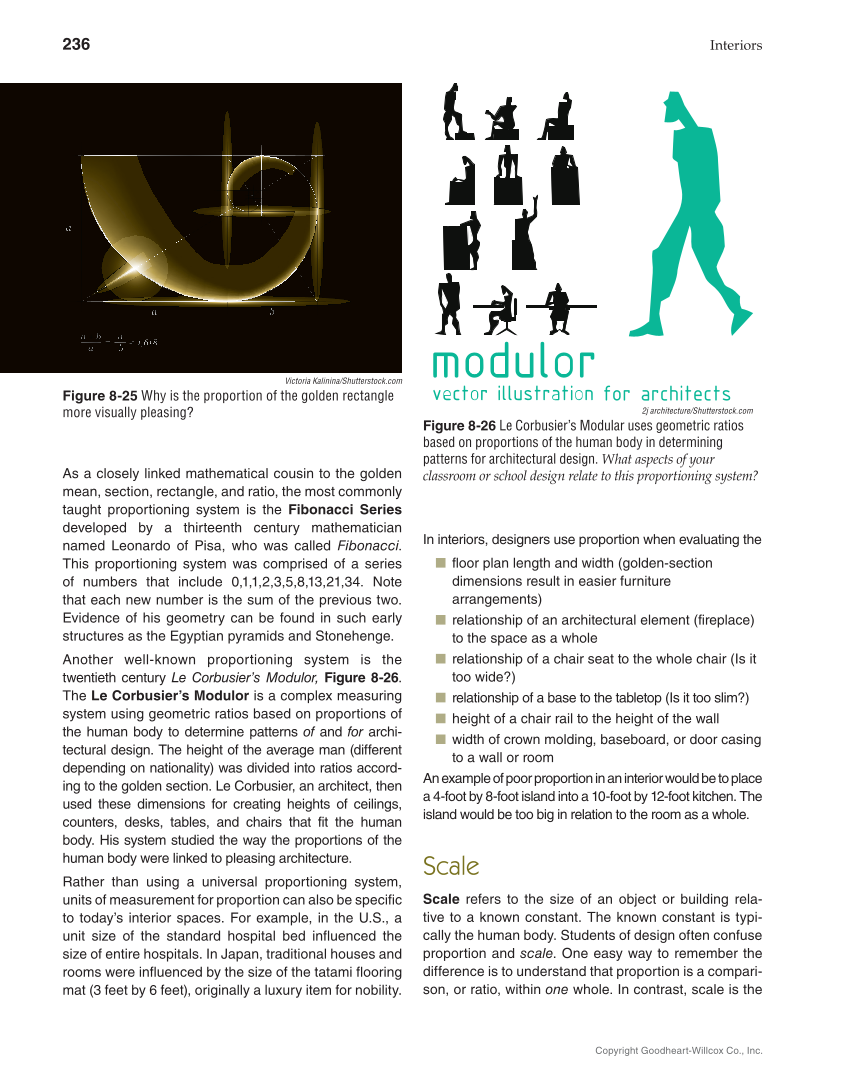236 Interiors Copyright Goodheart-Willcox Co., Inc. As a closely linked mathematical cousin to the golden mean, section, rectangle, and ratio, the most commonly taught proportioning system is the Fibonacci Series developed by a thirteenth century mathematician named Leonardo of Pisa, who was called Fibonacci. This proportioning system was comprised of a series of numbers that include 0,1,1,2,3,5,8,13,21,34. Note that each new number is the sum of the previous two. Evidence of his geometry can be found in such early structures as the Egyptian pyramids and Stonehenge. Another well-known proportioning system is the twentieth century Le Corbusier’s Modulor, Figure 8-26. The Le Corbusier’s Modulor is a complex measuring system using geometric ratios based on proportions of the human body to determine patterns of and for archi- tectural design. The height of the average man (different depending on nationality) was divided into ratios accord- ing to the golden section. Le Corbusier, an architect, then used these dimensions for creating heights of ceilings, counters, desks, tables, and chairs that fit the human body. His system studied the way the proportions of the human body were linked to pleasing architecture. Rather than using a universal proportioning system, units of measurement for proportion can also be specific to today’s interior spaces. For example, in the U.S., a unit size of the standard hospital bed influenced the size of entire hospitals. In Japan, traditional houses and rooms were influenced by the size of the tatami flooring mat (3 feet by 6 feet), originally a luxury item for nobility. In interiors, designers use proportion when evaluating the ■ floor plan length and width (golden-section dimensions result in easier furniture arrangements) ■ relationship of an architectural element (fireplace) to the space as a whole ■ relationship of a chair seat to the whole chair (Is it too wide?) ■ relationship of a base to the tabletop (Is it too slim?) ■ height of a chair rail to the height of the wall ■ width of crown molding, baseboard, or door casing to a wall or room An example of poor proportion in an interior would be to place a 4-foot by 8-foot island into a 10-foot by 12-foot kitchen. The island would be too big in relation to the room as a whole. Scale Scale refers to the size of an object or building rela- tive to a known constant. The known constant is typi- cally the human body. Students of design often confuse proportion and scale. One easy way to remember the difference is to understand that proportion is a compari- son, or ratio, within one whole. In contrast, scale is the 2j architecture/Shutterstock.com Figure 8-26 Le Corbusier’s Modular uses geometric ratios based on proportions of the human body in determining patterns for architectural design. What aspects of your classroom or school design relate to this proportioning system? Victoria Kalinina/Shutterstock.com Figure 8-25 Why is the proportion of the golden rectangle more visually pleasing?
